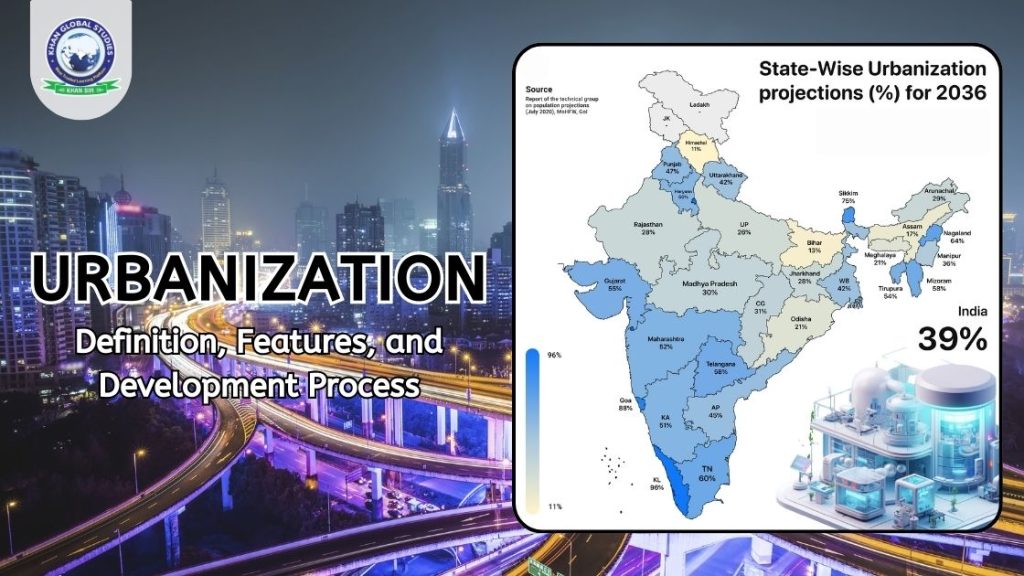Urbanization can be described as the change from Rural to Urban life, where people move to cities and shift their focus from agriculture to other activities taking place in urban areas, such as trade, manufacturing, industry and management.
This lifestyle change also includes changes in behaviour patterns. Essentially, urbanization is a process that involves the expansion of the entire system of interconnections that support the population in a given habitat. The term is used to describe a gradual increase in the proportion of people living in urban areas and the movement of people from rural to urban residences.
Features of Indian Urbanization
In India, the growth of towns is being driven mainly by the tertiary sector rather than the secondary sector. Ironically, the development of Indian cities has been the result of the growth of the tertiary sector, which includes the communication sector, transportation, services and manufacturing, whereas, in developed countries, it has been the dominant manufacturing sector. Area. The driving force behind urban development.
One reason for the higher level of urbanization in Southern India compared to Northern and Eastern India is the availability of historical, socio-cultural and educational resources. Furthermore, the introduction of globalization in India has led to significant development in the southern region, mainly due to high FDI and the establishment of various industries in these states.
Urbanization Process
Urbanization is usually associated with industrialization, as it is a structural process of change that often occurs concurrently with it. However, urbanization is not always a direct result of industrialization.
Instead, it can be triggered by the concentration of industrial and commercial, financial and administrative establishments in urban areas, as well as advances in transportation and communication technologies and cultural and recreational activities.
Urbanization is an essential aspect of economic development, as the economy grows, per capita income increases and the demand for non-agricultural goods in the economy also increases. In the Indian context, urbanization is considered a socio-cultural, economic and geographical process.
- Urbanization is a socio-cultural phenomenon involving the mixing of people of different ethnic, linguistic and religious backgrounds. Its example is Kolkata.
- As an economic process, urbanization is driven by productive activities taking place within cities. Cities depend on these economic activities to grow and develop. Its example is Mumbai.
- Urbanization is also a geographical process that involves the movement of people from one place to another. This may take the form of migration or changing one’s place of residence.
Development of Urbanization in India
Urbanization in India has a long and complex history, dating back to the Harappan civilization, considered one of the world’s first urban societies. The Indus Valley Civilization centered around the cities of Harappa and Mohenjo-Daro, existed from an estimated 2600 BCE to 1900 BCE, and had a population of over 5 million.
During the colonial era, British policies had an important impact on urbanization in India. British efforts to modernize the country’s infrastructure and economy led to the establishment of several large cities, including Mumbai, Kolkata and Chennai. These cities functioned as administrative and commercial centers for the British Raj and were home to growing urban populations.
After India gained independence in 1947, the government began to focus on developing the country’s urban areas as a means of promoting economic growth and improving living conditions. The first five-year plan, launched in 1951, included provisions for urban development, which included the creation of new cities and the improvement of existing infrastructure.
The subsequent five-year plans also emphasized urban development, with special attention given to the expansion of the country’s manufacturing and service sectors. As a result, India’s urban population has grown rapidly in recent decades, with cities such as Mumbai, Delhi and Bangalore emerging as major economic and cultural centres.
Today, the Government’s Urbanization Policies are guided by the Twelfth Five-Year Plan, which outlines a vision for sustainable urban development in India. The plan includes initiatives to boost economic growth, improve infrastructure and address environmental challenges associated with urbanization. As India modernizes and develops, urbanization will likely continue to play a central role in the country’s future growth and development.
A Major Contribution of the British to Indian Urban Development
- In 1687–88, the first municipal corporation was set up in Madras, marking the beginning of local self-government in India.
- In 1726, municipal corporations were established in Bombay and Calcutta.
- In 1882, Lord Ripon, the Viceroy of India, passed a resolution that led to the creation of Panchayats, District Boards, Taluka Boards and Municipalities at the village level.
- Lord Ripon’s proposal of 1882 is considered the Magna Carta of local self-government in India.
- The metropolitan port cities of Mumbai, Kolkata and Chennai were established.
- A series of hill stations such as Darjeeling, Shimla, Mussoorie and Lansdowne were built in the Himalayan region and South India.
- The urban landscape of existing towns was modified with the introduction of civil lines and cantonments.
- The introduction of railways and modern industry had an important impact on urbanization.
- During this period, improvements were made in urban facilities and administration.
- Modern education was introduced by establishing colleges and universities in major urban centres.
- After independence, urbanization accelerated due to the adoption of a mixed economy in the country, which led to the development of the private sector.
FAQs
Question: What is the definition of urbanization?
Answer: Urbanization is the process by which an increasing proportion of a country’s population moves from rural areas to cities and towns, resulting in the growth and expansion of urban areas.
Question: What is the meaning of urbanization in Hindi?
Answer: Urbanization in Hindi means “नगरीकरण” or “शहरीकरण”. It refers to the transformation of rural areas into urban centers due to population migration.
Question: What is the characteristic of urbanization in India?
Answer: Urbanization in India is characterized by the rapid growth of cities and towns, rural-to-urban migration and natural population growth. It involves the development of infrastructure, housing and services to accommodate the urban population.
Question: What are the major drivers of urbanization in India?
Answer: The major drivers of urbanization in India include rural-to-urban migration in search of better economic prospects, natural increase in urban population due to industrialization and higher birth rates in urban areas.
Question: How does urbanization affect the economy of a country?
Answer: Urbanization often has a positive impact on the economy by creating job opportunities, promoting industrialization and increasing productivity. This can lead to higher GDP and improved standards of living.
Question: What are some effects of urbanization?
Answer: The effects of urbanization include increased economic opportunities, access to better health care and education, improved infrastructure, and increased cultural diversity. However, this can also create challenges such as overcrowding, pollution and housing shortage.
Must Read:
- Migration: Definition, Types, Causes and Its Impacts
- Konark Temple के बारे में जानें सब कुछ: इतिहास और पौराणिक कथा




